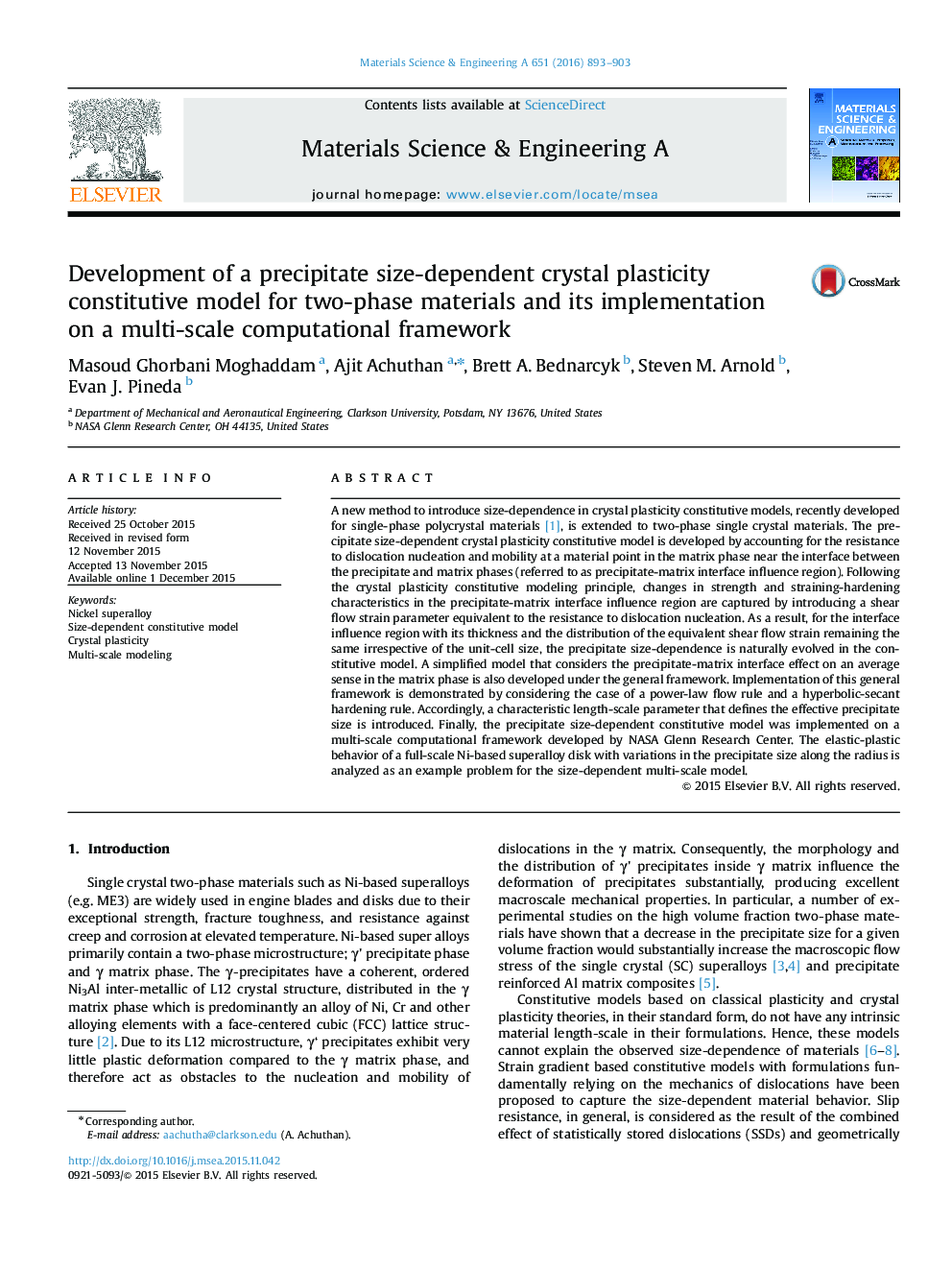| کد مقاله | کد نشریه | سال انتشار | مقاله انگلیسی | نسخه تمام متن |
|---|---|---|---|---|
| 7976328 | 1514692 | 2016 | 11 صفحه PDF | دانلود رایگان |
عنوان انگلیسی مقاله ISI
Development of a precipitate size-dependent crystal plasticity constitutive model for two-phase materials and its implementation on a multi-scale computational framework
ترجمه فارسی عنوان
توسعه یک مدل سازنده بلوری پراکندگی وابسته به اندازه رسوب برای مواد دو مرحله ای و اجرای آن در چارچوب محاسباتی چند مقیاس
دانلود مقاله + سفارش ترجمه
دانلود مقاله ISI انگلیسی
رایگان برای ایرانیان
کلمات کلیدی
ابررسانای نیکل، مدل سازنده وابسته به اندازه، پلاستیک کریستال، مدل سازی چند بعدی،
ترجمه چکیده
یک روش جدید برای معرفی اندازه وابستگی به مدل های سازنده پلاستیکی کریستال، اخیرا برای مواد تک فاز پلی کریستالی ساخته شده است [1]، به مواد تک فاز دو فاز گسترش یافته است. مدل سازنده ی پلاستیسیته ی بلوری وابسته به اندازه ی رسوب، با توجه به مقاومت در برابر نوکلئوتیدی و تحرک جابجایی در یک نقطه ی ماتریس در فاز ماتریس در نزدیکی رابط بین فاز های رسوب و ماتریکس (به عنوان منطقه نفوذ رابط ماتریس رسوب)، توسعه یافته است. با توجه به اصل مدل سازی پلاستیکی کریستال، تغییرات قدرت و ویژگی های سختی خمشی در رابط ماتریس رسوبی منطقه را تحت تأثیر قرار می دهند که با معرف پارامتر کششی برشی معادل مقاومت در برابر نوکلئوتیدی شدن جابجایی می شوند. در نتیجه، برای رابط کاربری نفوذ منطقه با ضخامت آن و توزیع فشار جریان برش معادل باقی مانده همان بدون در نظر گرفتن اندازه سلول واحد، وابستگی اندازه رسوب به طور طبیعی در مدل سازنده تکامل یافته است. یک مدل ساده شده که تاثیر رابط ماتریس رسوب را به معنای متوسط در فاز ماتریسی را تحت چارچوب کلی توسعه می دهد. پیاده سازی این چارچوب کلی با در نظر گرفتن یک قانون جریان جریان قدرت و یک قاعده تشدید هذلولی-مخفی نشان داده شده است. بر این اساس، یک پارامتر مشخصه در مقیاس طولی که میزان رسوب موثر را تعیین می کند معرفی می شود. در نهایت، مدل سازنده وابسته به اندازه رسوب در چارچوب محاسباتی چند بعدی توسعه یافته توسط مرکز تحقیقات گلن ناسا انجام شد. رفتار پلاستیک-پلاستیکی یک دیسک فوق العاده آلاینده بر پایه نیکل با مقیاس نیکل با تغییرات در حجم رسوب در طول شعاع به عنوان یک مشکل نمونه برای مدل چند بعدی مقیاس وابسته است.
موضوعات مرتبط
مهندسی و علوم پایه
مهندسی مواد
دانش مواد (عمومی)
چکیده انگلیسی
A new method to introduce size-dependence in crystal plasticity constitutive models, recently developed for single-phase polycrystal materials [1], is extended to two-phase single crystal materials. The precipitate size-dependent crystal plasticity constitutive model is developed by accounting for the resistance to dislocation nucleation and mobility at a material point in the matrix phase near the interface between the precipitate and matrix phases (referred to as precipitate-matrix interface influence region). Following the crystal plasticity constitutive modeling principle, changes in strength and straining-hardening characteristics in the precipitate-matrix interface influence region are captured by introducing a shear flow strain parameter equivalent to the resistance to dislocation nucleation. As a result, for the interface influence region with its thickness and the distribution of the equivalent shear flow strain remaining the same irrespective of the unit-cell size, the precipitate size-dependence is naturally evolved in the constitutive model. A simplified model that considers the precipitate-matrix interface effect on an average sense in the matrix phase is also developed under the general framework. Implementation of this general framework is demonstrated by considering the case of a power-law flow rule and a hyperbolic-secant hardening rule. Accordingly, a characteristic length-scale parameter that defines the effective precipitate size is introduced. Finally, the precipitate size-dependent constitutive model was implemented on a multi-scale computational framework developed by NASA Glenn Research Center. The elastic-plastic behavior of a full-scale Ni-based superalloy disk with variations in the precipitate size along the radius is analyzed as an example problem for the size-dependent multi-scale model.
ناشر
Database: Elsevier - ScienceDirect (ساینس دایرکت)
Journal: Materials Science and Engineering: A - Volume 651, 10 January 2016, Pages 893-903
Journal: Materials Science and Engineering: A - Volume 651, 10 January 2016, Pages 893-903
نویسندگان
Masoud Ghorbani Moghaddam, Ajit Achuthan, Brett A. Bednarcyk, Steven M. Arnold, Evan J. Pineda,
